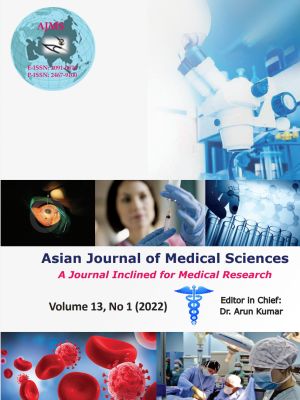Clinical profile of patients with hypertensive crisis in a tertiary care hospital in Haryana, India – A retrospective cross-sectional study
Keywords:
Hypertension, Hypertensive crisis, Hypertensive emergency, Hypertensive urgency, PrevalenceAbstract
Background: A hypertensive crisis may manifest as hypertensive emergency or urgency. Hypertensive emergency is characterized by target organ damage and poses immediate threat to life, a situation not seen in urgency.
Aims and Objectives: The aims of the study were as follows: (1) To determine the prevalence of hypertensive crisis classified as emergency, urgency, and pseudocrisis. (2) To assess the various systems (neurological, cardiovascular, and renal) affected in relation to a particular type of hypertensive crisis.
Materials and Methods: The retrospective study comprised analysis of medical records of 100 patients of hypertensive crisis admitted to emergency unit of BPS Government Medical College and Hospital for Women, Sonepat, Haryana, India, in the 2 years period from January 2018 to December 2019 and study their prevalence among hospital emergencies and clinical presentation.
Results: Total number of clinical emergencies analyzed during this time interval was 6666. The prevalence of hypertensive crisis accounted to 1.5% of all the clinical emergencies received. About 66% presented as hypertensive emergencies, 32% as hypertensive urgency, and 2% presented as hypertensive pseudocrisis. Males of the fifth decade of life while females of the sixth decade of life were most affected by hypertensive crisis. Headache (58%) followed by giddiness (44%) was the most common clinical presentation in the emergency. About 34% of patients had associated neurological deficit. Only 16% of patients had cardiovascular system involvement.
Conclusion: Symptoms provided by patients in the emergency department are of paramount importance for the outcome of hypertensive crisis. Severe complication of hypertensive crisis can be prevented if hypertension is timely diagnosed and appropriately managed.
Downloads
Downloads
Published
How to Cite
Issue
Section
License
Copyright (c) 2021 Asian Journal of Medical Sciences

This work is licensed under a Creative Commons Attribution-NonCommercial 4.0 International License.
Authors who publish with this journal agree to the following terms:
- The journal holds copyright and publishes the work under a Creative Commons CC-BY-NC license that permits use, distribution and reprduction in any medium, provided the original work is properly cited and is not used for commercial purposes. The journal should be recognised as the original publisher of this work.
- Authors are able to enter into separate, additional contractual arrangements for the non-exclusive distribution of the journal's published version of the work (e.g., post it to an institutional repository or publish it in a book), with an acknowledgement of its initial publication in this journal.
- Authors are permitted and encouraged to post their work online (e.g., in institutional repositories or on their website) prior to and during the submission process, as it can lead to productive exchanges, as well as earlier and greater citation of published work (See The Effect of Open Access).




